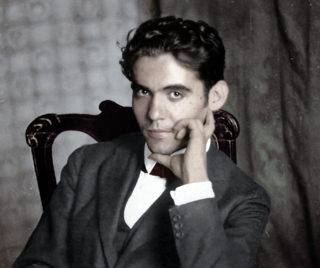Lorca, language, translation and a libation
Reading Lorca, and then reading about Lorca in Spanish Wikipedia, I think about the how the quiet poet becomes a rebel, not through any change in himself, but through his being an unchanging self while society around him changes.
 (photo courtesy KlimBim)
(photo courtesy KlimBim)
One thing I like about the Spanish Wikipedia apart from the intimacy of detail about his life, and a deeper cultural awareness, is the love for Lorca which seeps out, even through the translating engine. There is also a nice list of symbols which occur in Lorca’s poetry, which is absent from English Wikipedia. I notice that a lot of the symbols are supposed to be related to death:
- The moon: is the most frequent symbol in Lorca’s poems. Its most frequent meaning is that of death, but it can also symbolise eroticism, fertility, sterility or beauty.
- Water: when running, it is a symbol of vitality. When standing, it represents death.
- Blood: represents life and, spilled, is death. also symbolises sexual consummation.
- The horse (and its rider): is very present in all his work, always carrying shades of death, but also representing life and male eroticism.
- The bull: García Lorca was fond of bulls; according to his words: “I believe that the running of the bulls is the most cultured festival in the world. It is the pure drama in which the Spanish shed their best tears and their bile. It is the only place where he leaves with the certainty of seeing death surrounded by the most dazzling beauty (…)”.
- Herbs: its dominant value, although not unique, is that of being symbolic of death.
- The metals: their dominant value is also death. The metals appear in the form of silver swords, which always entail tragedy.
Lorca was part of a landowning family in Granada, so his murder in the early days of the fascist revolution in Spain in 1936 was perhaps in part because of his connexions to existing power structures which were being overthrown, as well as the power of his writing (if the two can be separated), and his homosexuality.
It is still not known where his body was buried, and it was only recently (2009) that the government approved the opening of the grave where his body was supposed to be – to find nothing there. There is little official record of his execution, in a local patch of forest, at a quarter to five in the morning of August 18. Many other executions, including that of Lorca’s brother in law, the mayor Manuel Fernández-Montesinos took place in the Granda Cemetary.
There seems to be a very very slow thawing of information coming out, and acceptance of what happened in those days. Such deeds, quickly committed, create wounds of long painful convalescence. America, sliding into fascism: take notice!
Reading these pages in translation, I am amazed at the improvements in translation software in recent years. I read that google now uses a new neural machine translation, and it is getting very good. At a lunch with some university language teachers last year, they were saying how their students learning Japanese are using translation software more and more to cheat on assignments – although they as teachers can still tell the difference, it is going to keep getting harder. I come across the blog of Ana Guerberof Areans, reading about a visit in the 1980s to Lorca’s house in Granada (which is now a museum), and I think about how translators, now that software can do the grunt work, now need to find more niche tasks. Poetry translations for instance.
Incidentally, the first truly computer created jokes are probably in their translation mistakes. Reading any page that has gone through a computer translator is likely to cause a few giggles, which is not a defect, but a sort of spicy seasoning in my opinion.
It is summer and I am drinking some bone dry amontillado. I pour a glass on the parched Australian earth in honour of Lorca. That is the libation.

